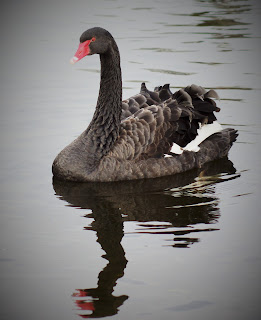There has been a Great White Egret at Maple Lodge NR for over 20 days now, but what with my recent eye problems and work shift patterns it was only yesterday (Tuesday 28th November) that I was able to get to the reserve to see the new star for myself.
It really is a stunning and handsome bird. It is favouring the lake in front of the Long Hedge Hide and Shell Hide, generally at the back by the reed beds and despite the skies above being busy with aircraft and helicopters it is taking them all in it's stride and showing no signs of being spooked by them....
On my visit there were no Little Egrets around to compare the great bird to, but Great Whites are quite a bit larger than Little Egrets, with all yellow beaks and black legs and feet. Little Egrets have black bills, black legs and yellow feet.
Below is a Grey Heron with the Great White Egret, both showing some interest in something that was happening over the other size of the lake and showing they are roughly the same size.....
 |
| view from Long Hedge Hide |
 |
| view from Shell Hide |
It didn't do a lot of fishing during my visit but it did do a lot of preening, which suggests to me it is very comfortable at the reserve....
In the farm fields there were lots of Canada and Greylag geese and by one of the far buildings there was a very pale goose. It was quite difficult photographing against the sun and the distance was a little too far for my little zoom lens, but I am pretty sure this is leucistic Greylag....
From the Wikipedia site - Leucism is a condition in which there is partial loss of pigmentation in an animal resulting in white, pale, or patchy coloration of the skin, hair, feathers, scales or cuticle, but not the eyes. Unlike albinism, it is caused by a reduction in multiple types of pigment, not just melanin.
At Comma Corner the tops of the trees were very busy with around 20 Redwings noisily flying from tree top to tree top. It was incredibly difficult to photograph them amongst the leafless twigs but one obligingly sat out in the open for me briefly.....
As to be expected at Maple Lodge there were plenty of over wintering ducks including the Shoveler below.....
and my favourite dabbler, the colourful Teals.....
I spent the last hour of my visit in the Club House Hide with a lovely hot cup of coffee to warm my hands up on. The feeders there attract all the small birds and the resident Robin was on his usual twig perch to the right of the hide window. He was joined occasionally by another Robin, so maybe he has attracted a mate already.....
The perch underneath was favoured by a couple of Dunnocks...
Whilst the Chaffinches and Great Tits perched where they could before flying down to the many feeders.....
The male Great Spotted Woodpecker appeared at his favoured nut feeder.....
Yet another naughty cat strode through the area like he/she owned the place....
and the Grey Squirrels done their usual 'statue' poses......
I had three tantalising glimpses of a Kingfisher but the nearest it perched to the hide was in the leafy whips of the large Willow on the left hand side......
Another successful and enjoyable visit to this hidden gem of a nature reserve. Lets hope the Great White Egret is a long term stayer.







































































